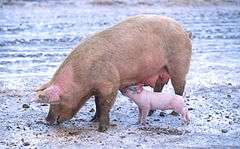Pig
A pig is any of the animals in the genus Sus, within the even-toed ungulate family Suidae. Pigs include domestic pigs and their ancestor, the common Eurasian wild boar (Sus scrofa), along with other species. Pigs, like all suids, are native to the Eurasian and African continents, ranging from Europe to Pacific islands. Suids other than the pig are the babirusa of Indonesia, the pygmy hog of Asia, the warthog of Africa, and another genus of pigs from Africa. The suids are a sister clade to peccaries.
| Pig Temporal range: Early Pleistocene to recent | |
|---|---|
.jpg) | |
| Bornean bearded pig at the London Zoo | |
| Scientific classification | |
| Kingdom: | Animalia |
| Phylum: | Chordata |
| Class: | Mammalia |
| Order: | Artiodactyla |
| Family: | Suidae |
| Subfamily: | Suinae |
| Genus: | Sus Linnaeus, 1758 |
| Species | |
| |
Juvenile pigs are known as piglets.[1] Pigs are highly social and intelligent animals.[2]
With around 1 billion individuals alive at any time, the domestic pig is among the most populous large mammals in the world.[3][4] Pigs are omnivores and can consume a wide range of food.[5] Pigs are biologically similar to humans and are thus frequently used for human medical research.[6]
Etymology
The Online Etymology Dictionary provides anecdotal evidence as well as linguistic, saying that the term derives
probably from Old English *picg, found in compounds, ultimate origin unknown. Originally "young pig" (the word for adults was swine). Apparently related to Low German bigge, Dutch big ("but the phonology is difficult" -- OED). ... Another Old English word for "pig" was fearh, related to furh "furrow," from PIE *perk- "dig, furrow" (source also of Latin porc-us "pig," see pork). "This reflects a widespread IE tendency to name animals from typical attributes or activities" [Roger Lass]. Synonyms grunter, oinker are from sailors' and fishermen's euphemistic avoidance of uttering the word pig at sea, a superstition perhaps based on the fate of the Gadarene swine, who drowned.[7]
The Online Etymology Dictionary also traces the evolution of sow, the term for a female pig, through various historical languages:
Old English sugu, su "female of the swine," from Proto-Germanic *su- (cognates: Old Saxon, Old High German su, German Sau, Dutch zeug, Old Norse syr), from PIE root *su- (cognates: Sanskrit sukarah "wild boar, swine;" Avestan hu "wild boar;" Greek hys "swine;" Latin sus "swine", suinus "pertaining to swine"; Old Church Slavonic svinija "swine;" Lettish sivens "young pig;" Welsh hucc, Irish suig "swine; Old Irish socc "snout, plowshare"), possibly imitative of pig noise; note that Sanskrit sukharah means "maker of (the sound) su.[7]
An adjectival form is porcine. Another adjectival form (technically for the subfamily rather than genus name) is suine (comparable to bovine, canine, etc.); for the family, it is suid (as with bovid, canid).
Description and behaviour
.jpg)
(Sus scrofa domesticus)
A typical pig has a large head with a long snout that is strengthened by a special prenasal bone and by a disk of cartilage at the tip.[8] The snout is used to dig into the soil to find food and is a very acute sense organ. There are four hoofed toes on each foot, with the two larger central toes bearing most of the weight, but the outer two also being used in soft ground.[9]
The dental formula of adult pigs is 3.1.4.33.1.4.3, giving a total of 44 teeth. The rear teeth are adapted for crushing. In the male, the canine teeth form tusks, which grow continuously and are sharpened by constantly being ground against each other.[8]
Occasionally, captive mother pigs may savage their own piglets, often if they become severely stressed.[10] Some attacks on newborn piglets are non-fatal. Others may cause the death of the piglets and sometimes, the mother may eat the piglets. It is estimated that 50% of piglet fatalities are due to the mother attacking, or unintentionally crushing, the newborn pre-weaned animals.[11]
Distribution and evolution
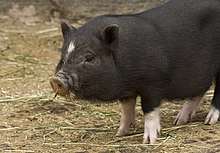
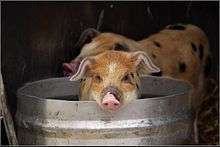
With around 1 billion individuals alive at any time, the domestic pig is one of the most numerous large mammals on the planet.[3][4]
The ancestor of the domestic pig is the wild boar, which is one of the most numerous and widespread large mammals. Its many subspecies are native to all but the harshest climates of continental Eurasia and its islands and Africa as well, from Ireland and India to Japan and north to Siberia.
Long isolated from other pigs on the many islands of Indonesia, Malaysia, and the Philippines, pigs have evolved into many different species, including wild boar, bearded pigs, and warty pigs. Humans have introduced pigs into Australia, North and South America, and numerous islands, either accidentally as escaped domestic pigs which have gone feral, or as wild boar.
Habitat and reproduction
The wild boar (Sus scrofa) can take advantage of any forage resources. Therefore, they can live in virtually any productive habitat that can provide enough water to sustain large mammals such as pigs. If there is increased foraging of wild boars in certain areas, they can cause a nutritional shortage which can cause the pig population to decrease. If the nutritional state returns to normal, the pig population will most likely rise due to the pigs' naturally increased reproduction rate.[12]
Diet and foraging
Pigs are omnivores, which means that they consume both plants and animals. In the wild, they are foraging animals, primarily eating leaves, roots, fruits, and flowers, in addition to some insects and fish. As livestock, pigs are fed mostly corn and soybean meal[13] with a mixture of vitamins and minerals added to the diet. Traditionally, they were raised on dairy farms and called "mortgage lifters", due to their ability to use the excess milk as well as whey from cheese and butter making combined with pasture.[14] Older pigs will consume three to five gallons of water per day.[15] When kept as pets, the optimal healthy diet consists mainly of a balanced diet of raw vegetables, although some may give their pigs conventional mini pig pellet feed.[16]
Relationship with humans
Domesticated pigs, especially miniature breeds, are commonly kept as pets.[17] Domestic pigs are raised commercially as livestock; materials that are garnered include their meat (known as pork), leather, and their bristly hairs which are used to make brushes. Because of their foraging abilities and excellent sense of smell, they are used to find truffles in many European countries. Both wild and feral pigs are commonly hunted.
The relatively short, stiff, coarse hairs of the pig are called bristles, and were once so commonly used in paintbrushes that in 1946 the Australian Government launched Operation Pig Bristle. In May 1946, in response to a shortage of pig bristles for paintbrushes to paint houses in the post-World War II construction boom, the Royal Australian Air Force (RAAF) flew in 28 short tons of pig bristles from China, their only commercially available source at the time.[18]
Use in human healthcare
Human skin is very similar to pig skin, therefore pig skin has been used in many preclinical studies.[19][20] In addition to providing use in biomedical research[21][19][20] and for drug testing,[22] genetic advances in human healthcare have provided a pathway for domestic pigs to become xenotransplantation candidates for humans.[23]
Species
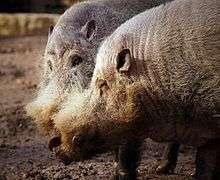
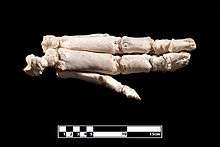
The genus Sus is currently thought to contain eight living species. A number of extinct species (†) are known from fossils.
- Sus ahoenobarbus Huet, 1888 – Palawan bearded pig
- †Sus australis Han, 1987 – Early Pleistocene of China
- Sus barbatus Müller, 1838 - Bornean bearded pig
- †Sus bijiashanensis Han et al., 1975 – Early Pleistocene of China
- †Sus bucculentus Heude, 1892 – Heude's pig or Indochinese (or Vietnam) warty pig
- Sus cebifrons Heude, 1888 – Visayan warty pig
- Sus celebensis Müller & Schlegel, 1843 – Celebes warty pig or Sulawesi warty pig
- †Sus falconeri – Pleistocene of the Siwalik region, India
- †Sus houi Qi et al., 1999 – Pleistocene of China
- †Sus hysudricus Falconer and Cautley 1847 – Pliocene of India
- †Sus jiaoshanensis Zhao, 1980 – Early Pleistocene of China
- †Sus liuchengensis Han, 1987 – Early Pleistocene of China
- †Sus lydekkeri Zdansky, 1928 – Pleistocene of China
- †Sus officinalis Koenigswald, 1933 – Middle Pleistocene of China
- Sus oliveri Groves, 1997 – Oliver's warty pig or Mindoro warty pig
- †Sus peii Han, 1987 – Early Pleistocene of China
- Sus philippensis Nehring, 1886 – Philippine warty pig
- Sus scrofa – Wild boar Linnaeus, 1758
- Sus scrofa domestica Erxleben, 1777 – Domestic pig (sometimes treated as a full species)
- †Sus subtriquetra Xue, 1981
- †Sus strozzi Forsyth Major, 1881 - Pliocene and Early Pleistocene of Europe
- Sus verrucosus Boie, 1832 – Javan warty pig
- †Sus xiaozhu Han et al., 1975 – Early Pleistocene of China
The pygmy hog, formerly Sus salvanius is now placed in the monotypic genus Porcula.[24]
Domestic pigs
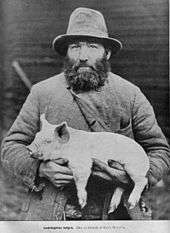
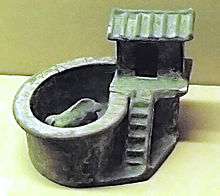
Pigs have been domesticated since ancient times in the Old World. Archaeological evidence suggests that pigs were being managed in the wild in a way similar to the way they are managed by some modern New Guineans from wild boar as early as 13,000–12,700 BP in the Near East in the Tigris Basin,[25] Çayönü, Cafer Höyük, Nevalı Çori.[26] Remains of pigs have been dated to earlier than 11,400 BP in Cyprus that must have been introduced from the mainland which suggests domestication in the adjacent mainland by then.[27] A separate domestication also occurred in China.[28]
In India, pigs have been domesticated for a long time mostly in Goa and some rural areas for pig toilets. This was also done in China. Though ecologically logical as well as economical, pig toilets are waning in popularity as use of septic tanks and/or sewerage systems is increasing in rural areas.
Pigs were brought to southeastern North America from Europe by Hernando de Soto and other early Spanish explorers. Pigs are particularly valued in China and on certain oceanic islands, where their self-sufficiency allows them to be turned loose, although the practice is not without its drawbacks (see environmental impact).
The domestic pig (Sus scrofa domesticus) is usually given the scientific name Sus scrofa, although some taxonomists call it S. domesticus, reserving S. scrofa for the wild boar. It was domesticated approximately 5,000 to 7,000 years ago. The upper canines form sharp distinctive tusks that curve outward and upward. Compared to other artiodactyles, their head is relatively long, pointed, and free of warts. Their head and body length ranges from 0.9 to 1.8 m (35 to 71 in) and they can weigh between 50 and 350 kg (110 and 770 lb).
In November 2012, scientists managed to sequence the genome of the domestic pig. The similarities between the pig and human genomes mean that the new data may have wide applications in the study and treatment of human genetic diseases.[29][30][31]
In August 2015, a study looked at over 100 pig genome sequences to ascertain their process of domestication. The process of domestication was assumed to have been initiated by humans, involved few individuals and relied on reproductive isolation between wild and domestic forms. The study found that the assumption of reproductive isolation with population bottlenecks was not supported. The study indicated that pigs were domesticated separately in Western Asia and China, with Western Asian pigs introduced into Europe where they crossed with wild boar. A model that fitted the data included admixture with a now extinct ghost population of wild pigs during the Pleistocene. The study also found that despite back-crossing with wild pigs, the genomes of domestic pigs have strong signatures of selection at DNA loci that affect behavior and morphology. The study concluded that human selection for domestic traits likely counteracted the homogenizing effect of gene flow from wild boars and created domestication islands in the genome. The same process may also apply to other domesticated animals.[32] [33]
In culture
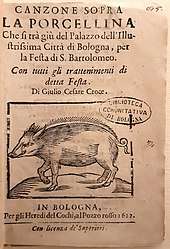
Pigs have been important in culture across the world since neolithic times. They appear in art, literature, and religion. In Asia the wild boar is one of 12 animal images comprising the Chinese zodiac, while in Europe the boar represents a standard charge in heraldry. In Islam and Judaism pigs and those who handle them are viewed negatively, and the consumption of pork is forbidden.[34][35] Pigs are alluded to in animal epithets and proverbs.[36][37] The pig has been celebrated throughout Europe since ancient times in its carnivals, the name coming from the Italian carne levare, the lifting of meat.[38]
Pigs have been brought into literature for varying reasons, ranging from the pleasures of eating, as in Charles Lamb's A Dissertation upon Roast Pig, to William Golding's Lord of the Flies (with the fat character "Piggy"), where the rotting boar's head on a stick represents Beelzebub, "lord of the flies" being the direct translation of the Hebrew בעל זבוב, and George Orwell's allegorical novel Animal Farm, where the central characters, representing Soviet leaders, are all pigs.[39][40][41][38]
Environmental impacts
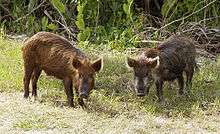
Domestic pigs that have escaped from urban areas or were allowed to forage in the wild, and in some cases wild boars which were introduced as prey for hunting, have given rise to large populations of feral pigs in North and South America, Australia, New Zealand, Hawaii, and other areas where pigs are not native. Accidental or deliberate releases of pigs into countries or environments where they are an alien species have caused extensive environmental change. Their omnivorous diet, aggressive behaviour, and their feeding method of rooting in the ground all combine to severely alter ecosystems unused to pigs. Pigs will even eat small animals and destroy nests of ground nesting birds.[8] The Invasive Species Specialist Group lists feral pigs on the list of the world's 100 worst invasive species and says:[42]
Feral pigs like other introduced mammals are major drivers of extinction and ecosystem change. They have been introduced into many parts of the world, and will damage crops and home gardens as well as potentially spreading disease. They uproot large areas of land, eliminating native vegetation and spreading weeds. This results in habitat alteration, a change in plant succession and composition and a decrease in native fauna dependent on the original habitat.
Health issues
Because of the biological similarities between each other, pigs can harbour a range of parasites and diseases that can be transmitted to humans. These include trichinosis, Taenia solium, cysticercosis, and brucellosis. Pigs are also known to host large concentrations of parasitic ascarid worms in their digestive tract.[43]
Some strains of influenza are endemic in pigs. Pigs also can acquire human influenza.
See also
- Wild boar
- Feral pig
- Domestic pig
- Miniature pig
- Peccary (domestication)
- Truffle hog
- Pot-bellied pig
- Babirusa
- Red river hog
- Bushpig
- Fetal pig
- Hog-baiting
- List of fictional pigs
- List of pigs
- Pig Olympics
- Enviropig
- Pig Beach
References
- "Piglet - Definition and More from the Free Merriam-Webster Dictionary". Merriam-webster.com. 31 August 2012. Retrieved 15 September 2013.
- Angier, Natalie (10 November 2009). "Pigs Prove to Be Smart, if Not Vain". The New York Times.
- "PSD Online - Custom Query". usda.gov.
- Swine Summary Selected Countries Archived 2012-03-29 at the Wayback Machine, United States Department of Agriculture, Foreign Agricultural Service, (total number is Production (Pig Crop) plus Total Beginning Stocks)
- "Pig And Human Digestive System". prezi.com. Retrieved 15 April 2016.
- Loren Grush (2015-03-24). "Why pigs are so valuable for medical research". Fox News. Retrieved 15 April 2016.
- Harper, Daniel (n.d.). "Sow". Online Etymology Dictionary. Retrieved December 4, 2015.
- "ADW: Sus scrofa: INFORMATION". Animal Diversity Web.
- Kim Lockhart. "American Wild Game / Feral Pigs / Hogs / Pigs / Wild Boar". gunnersden.com. Archived from the original on 2018-08-23. Retrieved 2018-12-03.
- Harris, M., Bergeron, R., Li1, Y. and Gonyou, H. (2001). "Savaging of piglets: A puzzle of maternal behaviour" (PDF). Retrieved July 31, 2013.CS1 maint: multiple names: authors list (link)
- North Carolina Pork Conference Archived 2007-08-20 at the Wayback Machine – Management Tips to Reduce Pre-Weaning Mortality. 2002. North Carolina State University.
- John J. Mayer and I. Lehr Brisbin, Jr., "Wild Pigs Biology, Damage, Control Techniques and Management" Archived 2013-10-30 at the Wayback Machine, Savannah River National Laboratory Aiken, South Carolina, 2009
- "Diet and Nutrition on Modern Pig Farms - Pork Cares". Pork Cares. Archived from the original on 2017-10-02. Retrieved 2017-10-17.
- "farmdoc - Marketing&Outlook: WILL HOGS RECLAIM "MORTGAGE LIFTER" STATUS?". illinois.edu. Archived from the original on 2013-08-12. Retrieved 2013-06-17.
- "How Much Water Do Pigs Need?". ncsu.edu.
- http://americanminipigassociation.com/mini-pig-education/mini-pig-nutrition/ Mini Pig Nutrition
- http://americanminipigassociation.com American Mini Pig Association
- "29 May 1946 - PIG BRISTLES FOR PAINT BRUSHES - Trove". Trove. Retrieved 15 April 2016.
- Herron, Alan J. (5 December 2009). "Pigs as Dermatologic Models of Human Skin Disease" (PDF). ivis.org. DVM Center for Comparative Medicine and Department of Pathology Baylor College of Medicine Houston, Texas. Retrieved 27 January 2018.
pig skin has been shown to be the most similar to human skin. Pig skin is structurally similar to human epidermal thickness and dermal-epidermal thickness ratios. Pigs and humans have similar hair follicle and blood vessel patterns in the skin. Biochemically pigs contain dermal collagen and elastic content that is more similar to humans than other laboratory animals. Finally pigs have similar physical and molecular responses to various growth factors.
- Liu, J., Kim, D., Brown, L., Madsen, T., Bouchard, G. F. "Comparison of Human, Porcine and Rodent Wound Healing With New Miniature Swine Study Data" (PDF). sinclairresearch.com. Sinclair Research Centre, Auxvasse, MO, USA; Veterinary Medical Diagnostic Laboratory, Columbia, MO, USA. Retrieved 27 January 2018.
Pig skin is anatomically, physiologically, biochemically and immunologically similar to human skin
CS1 maint: multiple names: authors list (link) - "British MoD surgeons practise operations on drugged pigs which are strung-up and shot by marksmen to simulate warzone first aid". Daily Mail. 2014-02-18.
- Swindle, M. M.; Makin, A.; Herron, A. J.; Clubb, F. J.; Frazier, K. S. (2012). "Swine as Models in Biomedical Research and Toxicology Testing". Veterinary Pathology. 49 (2): 344–356. doi:10.1177/0300985811402846. PMID 21441112.
- Jeffery, Simon (2002-01-03). "Pig to Human transplants". The Guardian.
- Funk, Stephan M.; Kumar Verma, Sunil; Larson, Greger; Prasad, Kasturi; Singh, Lalji; Narayan, Goutam; Fa, John E. (2007). "The pygmy hog is a unique genus: 19th century taxonomists got it right first time round". Molecular Phylogenetics and Evolution. 45 (2): 427–436. doi:10.1016/j.ympev.2007.08.007. PMID 17905601.
- Rosenberg, M; Nesbitt, R; Redding, RW; Peasnall, BL (1998). "Hallan Cemi, pig husbandry, and post-Pleistocene adaptations along the Taurus-Zagros Arc (Turkey)"". Paleorient. 24 (1): 25–41. doi:10.3406/paleo.1998.4667.
- Ottoni, C.; Girdland Flink, L.; Evin, A.; Geörg, C.; De Cupere, B.; Van Neer, W.; Bartosiewicz, L.; Linderholm, A.; Barnett, R.; Peters, J.; Decorte, R.; Waelkens, M.; Vanderheyden, N.; Ricaut, F. X.; Çakırlar, C.; Cevik, O.; Hoelzel, A. R.; Mashkour, M.; Mohaseb Karimlu, A. F.; SheikhiSeno, S.; Daujat, J.; Brock, F.; Pinhasi, R.; Hongo, H.; Perez-Enciso, M.; Rasmussen, M.; Frantz, L.; Megens, H. J.; Crooijmans, R.; et al. (2012). "Pig domestication and human-mediated dispersal in western Eurasia revealed through ancient DNA and geometric morphometrics". Molecular Biology and Evolution. 30 (4): 824–832. doi:10.1093/molbev/mss261. PMC 3603306. PMID 23180578.
- Vigne, JD; Zazzo, A; Saliège, JF; Poplin, F; Guilaine, J; Simmons, A (2009). "Pre-Neolithic wild boar management and introduction to Cyprus more than 11,400 years ago". Proc Natl Acad Sci U S A. 106 (38): 16135–16138. Bibcode:2009PNAS..10616135V. doi:10.1073/pnas.0905015106. PMC 2752532. PMID 19706455.
- Giuffra, E; Kijas, J. M.; Amarger, V; Carlborg, O; Jeon, J. T.; Andersson, L (April 2000). "The origin of the domestic pig: independent domestication and subsequent introgression". Genetics. 154 (4): 1785–91. PMC 1461048. PMID 10747069.
- "Scientists Sequence Entire Pig Genome in Breakthrough That Could Combat Human Disease". 2012-11-14.
- "Scientists decode the pig genome". Business Standard India. 2012-11-15.
- Groenen, Martien A. M.; Archibald, Alan L.; Uenishi, Hirohide; Tuggle, Christopher K.; Takeuchi, Yasuhiro; Rothschild, Max F.; Rogel-Gaillard, Claire; Park, Chankyu; Milan, Denis; Megens, Hendrik-Jan; Li, Shengting; Larkin, Denis M.; Kim, Heebal; Frantz, Laurent A. F.; Caccamo, Mario; Ahn, Hyeonju; Aken, Bronwen L.; Anselmo, Anna; Anthon, Christian; Auvil, Loretta; Badaoui, Bouabid; Beattie, Craig W.; Bendixen, Christian; Berman, Daniel; Blecha, Frank; Blomberg, Jonas; Bolund, Lars; Bosse, Mirte; Botti, Sara; et al. (2012). "Analyses of pig genomes provide insight into porcine demography and evolution". Nature. 491 (7424): 393–8. Bibcode:2012Natur.491..393G. doi:10.1038/nature11622. PMC 3566564. PMID 23151582.
- Frantz, L (2015). "Evidence of long-term gene flow and selection during domestication from analyses of Eurasian wild and domestic pig genomes". Nat. Genet. 47 (10): 1141–8. doi:10.1038/ng.3394. PMID 26323058.
- Pennisi, E (2015). "The taming of the pig took some wild turns". Science. doi:10.1126/science.aad1692.
- Qur'an 2:173, 5:3, 6:145, and 16:115.
- Leviticus 11:3–8
- Horwitz, Richard P. (2002). Hog Ties: Pigs, Manure, and Mortality in American Culture. University of Minnesota Press. p. 23. ISBN 0816641838.
- "Fine Swine". The Daily Telegraph. 2 February 2001.
- Komins, Benton Jay (2001). "Western Culture and the Ambiguous Legacies of the Pig". CLCWeb: Comparative Literature and Culture. 3 (4). doi:10.7771/1481-4374.1137. ISSN 1481-4374.
- Mullan, John (21 August 2010). "Ten of the best pigs in literature". The Guardian.
- Bragg, Melvyn. "Topics - Pigs in literature". BBC Radio 4. Retrieved 1 January 2020.
Animal Farm ... Sir Gawain and the Green Knight ... The Mabinogion ... The Odyssey ... (In Our Time)
- Sillar, Frederick Cameron (1961). The symbolic pig: An anthology of pigs in literature and art. Oliver & Boyd.
- "issg Database: Ecology of Sus scrofa". issg.org.
- "Pig Health". The Pig Site.
